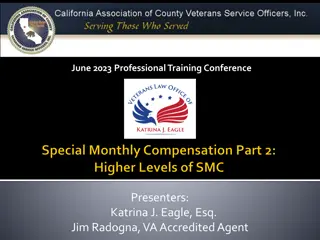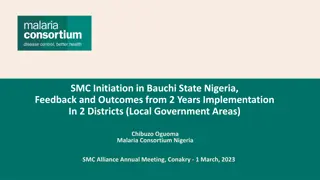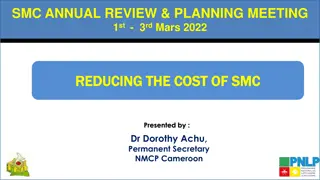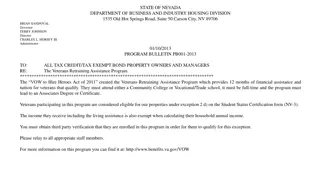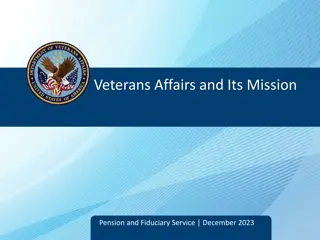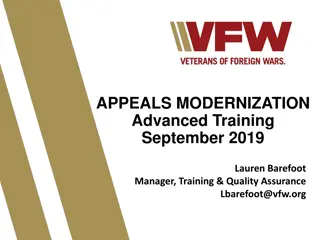Special Monthly Compensation (SMC) for Veterans
Special Monthly Compensation (SMC) is a vital benefit paid in addition to regular compensation for veterans with severe service-connected disabilities. SMC provides extra support for disabilities involving anatomical loss, sensory impairments, creative organ loss, or need for aid and attendance. Veterans may qualify for varying rates based on the level of disability. Entitlement to SMC is crucial and requires evidence to establish eligibility progressively.
Download Presentation

Please find below an Image/Link to download the presentation.
The content on the website is provided AS IS for your information and personal use only. It may not be sold, licensed, or shared on other websites without obtaining consent from the author.If you encounter any issues during the download, it is possible that the publisher has removed the file from their server.
You are allowed to download the files provided on this website for personal or commercial use, subject to the condition that they are used lawfully. All files are the property of their respective owners.
The content on the website is provided AS IS for your information and personal use only. It may not be sold, licensed, or shared on other websites without obtaining consent from the author.
E N D
Presentation Transcript
Spring 2023 Professional Training Conference Winter 2023 Professional Training Conference Winter 2023 Professional Training Conference 2023 Winter Professional Training Conference Presenters: Katrina J. Eagle, Esq. Jim Radogna, VA Accredited Agent
Special Monthly Compensation (SMC) is a benefit established through statute that is paid in addition to the basic rates of compensation payable under the Schedule for Rating Disabilities (10%-100%). SMC is paid to compensate veterans for service-connected disabilities that involve anatomical loss or loss of use, such as loss of use of a hand or a foot; impairment of the senses, such as loss of vision or hearing; loss of use of a creative organ; or the need for aid and attendance as a result of service- connected disabilities. While the basic rates of compensation are predicated on the average reduction in earning capacity, special monthly compensation benefits are meant to provide additional compensation based on noneconomic factors such as personal inconvenience, social inadaptability, or the profound nature of the disability. 2
38 U.S. Code 1114(a) Compensation rate at 10% disabling 38 U.S. Code 1114(b) Compensation rate at 20% disabling 38 U.S. Code 1114(c) Compensation rate at 30% disabling 38 U.S. Code 1114(d) Compensation rate at 40% disabling 38 U.S. Code 1114(e) Compensation rate at 50% disabling 38 U.S. Code 1114(f) Compensation rate at 60% disabling 38 U.S. Code 1114(g) Compensation rate at 70% disabling 38 U.S. Code 1114(h) Compensation rate at 80% disabling 38 U.S. Code 1114(i) Compensation rate at 90% disabling 38 U.S. Code 1114(j) Compensation rate at 100% disabling 3
+$884.89 +$1,117.88 +$1,351.81 +$1,693.56 +$2,036.07 +$2,368.89 +$2,702.31 +$5,414.94 +$6,753.58 +$432.17 SMC-K amount is paid in addition to regular monthly compensation ($3,621.95 + $128.62), all other levels are in place of regular monthly compensation. 4
Special Monthly Compensation is an inferred issue (see 38 C.F.R 3.155(d)(2)). VA raters are obligated to consider entitlement to SMC in all decisions where the medical evidence indicates possible entitlement. Generally speaking, no specific claim form is required for SMC, but you may need to submit evidence of entitlement because it may not be obvious from the medical evidence in the records. The basic levels of SMC are the building blocks to the higher levels of SMC. The basic levels include entitlement to individual loss or loss of use of extremities, loss of senses, entitlement to housebound benefits, and basic entitlement to regular aid and attendance. Entitlement to basic SMC benefits must be established first; then, the higher rates can be considered. 5
The anatomical loss or loss of use of One foot One hand Both buttocks One or more creative organs Loss of 25 percent or more of the tissue from a single breast or both breasts in combination (including loss by mastectomy or partial mastectomy), or when breast tissue has been subjected to radiation treatment (female veterans only). Blindness of one eye Deafness of both ears Complete organic aphonia (loss of voice) 38 U.S.C. 1114(k); 38 C.F.R. 3.350(a) 7
Loss of use of a hand or foot is held to exist when its function would be no better than if the hand or foot were amputated below the elbow or knee and replaced by a suitable prosthesis. Complete ankylosis of two major joints of an upper or lower extremity also establishes loss of use (i.e. the joints are frozen in place). What can the person do with that extremity? Is there any effective useful function remaining? Function may be described in terms of grasping and manipulation. For example, if a veteran can t pick up a coin, hold a screwdriver or button a shirt, loss of use could be established. A veteran would also be entitled to SMC-K if his arm was ankylosed at the shoulder in a position above his head. He can manipulate his fingers and grasp tools but can t reach his mouth with his hand. 8
Normal functions of the foot include balance and propulsion (push off his or her foot). Lack of balance and propulsion prevents ambulation. Can the veteran walk or is the foot able to support the veteran s weight? If a veteran can t balance on his foot or push off from the foot in walking, he/she may be entitled to the benefit. Other factors that establish loss of use of a foot include: Extremely unfavorable* complete ankylosis of the knee Complete ankylosis of two major joints of an extremity Shortening of the lower extremity 3 1/2 inches or more Complete paralysis of the external popliteal (common peroneal) nerve and consequent foot drop, accompanied by characteristic organic changes. *Favorable ankylosis means the joint is frozen in a straight position; unfavorable ankylosis means the joint is frozen in a bent position 9
Loss of use of both buttocks exists when there is severe damage by disease or injury to muscle group XVII and inability to rise without assistance from a seated or stooped position and the inability to maintain postural stability (i.e., stand erect). Entitlement to SMC-K for loss of use of both buttocks requires that each buttock be evaluated at 50 percent. If the veteran's own hands or arms are used to rise or a special appliance is used for postural stability, SMC will still be established. SMC-K for loss of use of both buttocks is payable even when there is separate entitlement to SMC for loss or loss of use of both extremities if additional loss is shown. 10
Loss of use of a creative organ includes: Loss of one or both testicles or one or both ovaries Atrophy of a testicle Male veteran undergoing removal of epididymis or prostate gland Female veteran undergoing removal of uterus or fallopian tube Male veteran suffering from retrograde ejaculation, or spermatozoa dumping into the bladder Male veteran suffering from loss of erectile power There is entitlement to SMC-K only once even though there may be loss or loss of use of more than one creative organ. For example, the anatomical loss of both testicles or the removal of the uterus and ovaries will only count as one (k) regardless of whether both losses occur at the same time or separately. Loss or loss of use of a creative organ traceable to an elective operation performed subsequent to service won t establish entitlement to the benefit. 11
SMC-K can be established for the loss or use or blindness of one eye when there is light perception only (LPO). This also includes anatomical loss of the eye. LPO is held to exist when there is inability to recognize test letters at a distance of one foot and when further examination of the eye reveals that perception of objects, hand movements, or counting fingers cannot be accomplished at three feet. In effect, loss of use of one eye means that, were vision in the good eye to be lost, total blindness would result. All determinations of visual impairment will be based on best corrected vision. When total blindness in one eye is service-connected and the veteran has suffered total blindness in the other eye as the result of a non-service-connected disability not the result of his/her own willful misconduct, compensation for total blindness in both eyes will be established as though both eyes were service- connected. SMC-K will not be paid when the affected eye is amenable to correction better than light perception. 12
SMC-K for deafness of both ears is defined as the absence of air and bone conduction. This absence is held to exist when examination by a licensed audiologist under current testing criteria shows that bilateral hearing loss is equal to or greater than the minimum bilateral hearing loss required for a maximum rating evaluation under the rating schedule. A numerical designation of "XI," or 100%, in both ears meets this requirement while a designation of less than XI in either ear will preclude entitlement. If total deafness in one ear is service-connected and the veteran suffered total deafness in the other ear as the result of a nonservice-connected disability, not the result of his/her own willful misconduct, the total deafness in both ears will be rated as if service-connected and the veteran will be entitled to SMC-K. The total deafness of both ears must be permanent. 13
Complete organic aphonia exists when there is a disability of the organs of speech that constantly precludes communication by speech. Such disability will most frequently result from the loss or paralysis of an organ of speech, such as the tongue or larynx. Aphasia is the inability to communicate due to some brain dysfunction and it does not grant entitlement to SMC-K. Aphonia, on the other hand, has an organic basis. In order to meet the requirements for SMC-K, the veteran must be unable to communicate by voice or whisper through normal speech. If a veteran suffers loss of speech due to a stroke, he or she will not be entitled to SMC-K because the aphonia must have an organic basis. The use of other organs of the body or prosthetic devices to provide voice sound will not preclude entitlement to SMC-K. 14
Loss of use due to functional hysteria or conversion reaction (i.e., unexplained neurological deficits such as paralysis or sensory losses) may be established assuming that permanence is established. When anatomical loss or loss of use of a hand or foot is service connected and the veteran has suffered loss or loss of use of the other paired extremity as the result of non- service-connected disability not the result of his/her own willful misconduct, compensation will be established as if both extremities were service-connected. This can lead to higher levels of SMC. 15
When a veteran suffers a single loss, say loss of use of a foot, only one level of SMC is payable, which is SMC-K. It doesn't matter whether the loss is at the foot, knee or hip; only SMC-K may be paid for a single extremity loss. The veteran with amputation above the knee does, however, receive a higher level of regular compensation at the 60 percent rate than the veteran who has loss of use of the foot who receives compensation at the 40 percent rate (because 40% is the rating for below the knee loss). A veteran may be eligible for more than one SMC-K if he/she meets the criteria for each condition (e.g., loss of foot + loss of use of creative organ). A veteran can receive SMC-K in addition to other Levels of SMC. According to the M21 manual, the responsibility for determining whether there is loss of use rests with the rater and cannot be delegated to the examining physician (VIII.iv.4.A.1.c.). However, a medical opinion from the veteran s treating provider can be very important if the rater denies loss of use. 16
SMC-S is payable when there is a single 100% service-connected evaluation and EITHER: The veteran also has additional separate & distinct service-connected disabilities rated at 60% or more (combined) involving different anatomical segments or bodily systems; (A/K/A Statutory Housebound or S-1 ) OR The single 100% service-connected disability by itself or in combination with other SC disabilities, causes the veteran to be confined to the area of his/her dwelling or immediate premises, and it is reasonably certain that the disabilities will continue through his or her lifetime (A/K/A Housebound in Fact or S-2 ). In both cases, there MUST be a single 100% evaluation. 1. 2. 38 U.S.C. 1114(s); 38 C.F.R. 3.350(i) 17
The 100% evaluation must be 100% schedular from a single disability or TDIU from a single disability. As many of you know, for purposes of TDIU, 38 CFR 4.16 states that the following will be considered as one disability: (1) Disabilities of one or both upper extremities, or of one or both lower extremities, including the bilateral factor, if applicable, (2) disabilities resulting from common etiology or a single accident, (3) disabilities affecting a single body system, e.g. orthopedic, digestive, respiratory, cardiovascular-renal, neuropsychiatric, (4) multiple injuries incurred in action, or (5) multiple disabilities incurred as a prisoner of war. The above definition of one disability is NOT APPLICABLE for purposes of SMC-S (i.e., the TDIU rating must be a result of only one disability to qualify for SMC-S). However, the fact that the total disability and the independent 60% disabilities result from a common etiological agent will not preclude entitlement. In other words, the 100% and the 60% can both be from the same disease or accident (e.g., 100% evaluation for DMII plus combined 60% for diabetic peripheral neuropathy or 100% TBI plus combined 60% knee ratings from same accident). 18
A housebound in fact determination does not require a total inability to leave the place of residence and immediate premises for all circumstances. Leaving home for medical purposes cannot, by itself, serve as the basis for finding that a Veteran is not substantially confined for purposes of SMC housebound benefits. Non-medical indicators of housebound status may include, but are not limited to: Inability to walk substantial distances Leaving the home with assistance only occasionally for appointments, grocery shopping, or church Inability to mow one s lawn 19
There is no requirement that either the 100 percent or the 60% rating be permanent for Statutory Housebound. For example, temporary SMC-S can be granted for active cancer plus 60% but removed after remission; or for 100% convalescent rating plus 60% but removed after convalescence is ended. For Housebound in Fact, entitlement is based on a single 100% disability plus a factual determination that the veteran is permanently housebound as a result of service-connected disabilities. This means that he or she is confined to the place of residence or immediate premises or, if institutionalized, to the ward or clinic areas. So, Statutory Housebound SMC-S can be temporary but Housebound in Fact will not be given as a temporary entitlement. 20
Since TDIU granted for multiple disabilities does not count for SMC-S purposes, be mindful when filling out a TDIU application (21-8940). In other words, if the veteran s 70% PTSD renders him or her unemployable by itself, it probably wouldn t make sense to also include another minor disability on the 8940. Even if TDIU is initially based on multiple disabilities, if, at a later point in time, a single disability becomes severe enough to warrant TDIU on its own, you can apply for SMC-S because VA is obligated to maximize a veteran s benefits (see 38 CFR 3.103(a): it is the obligation of VA to assist a claimant in developing the facts pertinent to the claim and to render a decision which grants every benefit that can be supported in law ) SMC-K ratings can be awarded in addition to SMC-S (but can t exceed the amount of the next higher level SMC-L). 21
The following combinations of loss/loss of use for lower and upper extremities and vision loss will entitle a veteran to SMC-L: Anatomical loss or loss of use of both feet. Anatomical loss or loss of use of one hand and one foot. Blindness in both eyes with vision 5/200 or less or the visual field restricted to 5 degrees or less. SMC-L is also available to a veteran who is: Permanently bedridden, or In need of aid and attendance (A&A) 38 U.S.C. 1114(l); 38 C.F.R. 3.350(b) Since Aid and Attendance is the most common way to qualify for SMC-L, let s start there 22
The criteria for entitlement to Aid and Attendance (A&A), which appear in 38 CFR 3.352(a), mandate that the Veteran be so helpless due to physical or mental incapacity that the aid of another person is required to perform the personal functions necessary for everyday living. Both the nature of the impairment (being in need of regular A&A) and the compensation indicate that a greater level of disability is required for entitlement to the additional allowance for A&A than for entitlement to SMC at the housebound rate, or a 100-percent schedular evaluation. A single disability rated 100% must be the sole or partial cause of the need for A&A (there are some exceptions to the 100% requirement, discussed later). A&A may be awarded even if the disability causing the need is not permanent. A&A is an inferred issue if the evidence shows entitlement (see 38 C.F.R 3.155(d)(2)), but it s likely that you ll need to point out entitlement to VA with evidence because medical records often don t detail need for A&A. 23
The following factors will be considered in determining whether the veteran is entitled to SMC based on need for aid and attendance: Inability to dress or undress without assistance Inability to keep ordinarily clean and presentable without assistance Inability of claimant to feed himself or herself without assistance Inability to attend to the wants of nature Incapacity that requires care or assistance on a regular basis to protect the claimant from the hazards or dangers incident to his or her daily environment. A veteran does not have to demonstrate that he or she needs the aid and attendance of another to accomplish all of the tasks described in the regulation (even one of the above can be sufficient). The particular personal functions which the veteran is unable to perform should be considered in connection with his or her condition as a whole. 24
The need for A&A must be regular but need not be constant. The veteran only needs to show that he or she is in need of aid and attendance on a regular basis. Generally, aid and attendance requires a single service-connected disability (but there are exceptions). A single disability for the purposes of establishing SMC-L also includes the following: if the veteran has a 100% combined schedular evaluation as the result of a single disease process, such as diabetes mellitus or Parkinson s disease, manifested by multiple disabilities, or has a 100% combined schedular evaluation for a primary service-connected disability and its secondary service-connected disabilities, and the evidence supports a need for regular A& A, SMC-L is warranted. (NOTE: This is different from SMC-S where multiple disabilities due to a common etiology may NOT be considered a single disability). However, all of the 38 CFR 4.16 (TDIU) single disability definitions (slide 18) do not apply to what constitutes a single disability for A&A determinations, only a single disease process. If a disability is rated less than 100% but a recent examination shows that the disability is so severe as to demonstrate a need for regular A& A, the VA regional office is obligated to submit the claim to the Director, Compensation Service for an advisory opinion (i.e., extraschedular A&A). BVA has also granted A&A with less than 100% when entitlement has been shown. 25
A veteran seeking SMC because he or she is in need of regular aid or attendance does not have to submit evidence that the disabling condition requires that the veteran be in bed, only that the veteran requires personal assistance from others. The VA must rely on competent medical evidence in making a determination on aid and attendance. The aid and assistance can be provided by the spouse, family member, or neighbor of the veteran it does not have to be provided by a professional or an outsider. Whether the veteran pays for regular assistance does not matter. Aid and attendance benefits are available to both physically and mentally disabled veterans. 26
Bedridden will be that condition that, through its essential character, which actually requires that the claimant remain in bed. The fact that the claimant has voluntarily taken to bed or that a physician has prescribed rest in bed for the greater or lesser part of the day to promote convalescence or cure will not suffice. If a veteran is hospitalized long enough at VA expense, aid and attendance will be reduced, normally to the housebound rate (SMC- S). If care is provided by a facility at the veteran s expense rather than VA s expense there is no reduction to the A&A amount. But If a veteran is bedridden due to service-connected disabilities there will be no reduction based on hospitalization at VA expense. 27
If possible, have this form filled out by the veteran s health care provider for either Housebound-In-Fact (SMC-S2) or Aid & Attendance (SMC-L) 28
Entitlement to SMC is an inferred issue and VAs failure to properly award SMC could be a clear and unmistakable error in a final decision. But VA can only infer SMC if they are aware of the veteran s current condition. Veterans suffering from degenerative diseases such as Parkinson s, Multiple Sclerosis or even Diabetes may eventually qualify for SMC as their conditions worsen. That s why it s incumbent on advocates to ask their veterans to keep them apprised of any future loss of uses, need for A&A, etc. Stay tuned for our Special Monthly Compensation Part 2 presentation in June. We ll be discussing the higher levels of SMC from SMC-M to SMC-T 29
Feel free to contact us about questions from this training or ANYTIME you have a question about a claim: CACVSO@eagleveteranslaw.com 31


